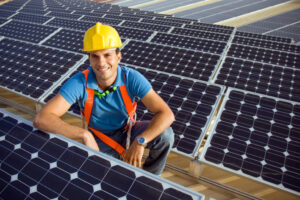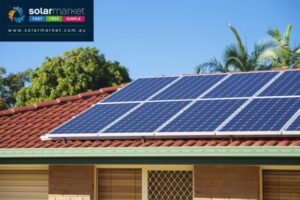Most commercially available solar panels on the market today are mono or poly crystalline which have an efficiency of approximately 14-15%. There has been a slow emergence of thin film technology but since these are still only sitting at efficiencies of 9% they have not yet become widely competitive with the classic crystalline cells.
In recent years, after the global financial crisis and scale back on government rebates for solar, less research has gone into improving the efficiency of cells. More of it has gone into improving the efficiency of making cells.
The components that go to make up a solar cell are actually reasonably expensive; silicon and silver being the most expensive of the lot.
Therefore if you can make a solar cell that does the same with less material or less material loss during manufacturing then your competitiveness in the market place goes up by that much.
The key here is uniformity. If you look at Q-Cells or Conergy factories you’ll see a highly advanced, automated factory line that churns out thousands of solar cells a day.
The machinery used has been finely tuned such that it’ll produce a high quality cell with minimal materials required.
So, if you can get a gram less silicon in a cell and get it to do the same job then that means you’ve used a gram less silicon in each of the 50,000 cells you’ve produced today.
If you’ve made it so you get 1% less cells that failed benchmark tests then that adds up to a lot of money when you’re talking these size economies.
How does this affect solar cell efficiency?
Solar cell efficiency is affected in two ways:
- Less research money from the big industry suppliers
- Harder for new technology to penetrate marketLess money for researchPrivate industry is where most of the money is. If this is mainly focused on producing the same cell for less then there’s less resources to go around making a more efficient cell.However, there are always significant leaps and innovations made by research organisations or universities.In fact various forms of thin film technology are gaining on the classic crystalline panels and newer more advanced crystalline panels are reaching up to and beyond 20% efficiency.So why aren’t we seeing them?
This leads onto the next point: Market Penetration
As mentioned before, the solar industry is a finely tuned machine squeezing out as much efficiency as possible from its tried and true production process.
So altering your operations to bring in a significantly different technology means:
- The cost of retro-fitting factories for new technology
- Shutting down production for retro-fitting (losing all the batches you would have made if the factory was still operating)
- Taking a step backwards in production efficiencyThese are all highly expensive repercussions from bringing in a new technology. For it to be worthwhile the benefit must out weigh the cost.A significant enough improvement in efficiency must be seen to incentivise a shift in production. Even then if the market is not in a good place (e.g. the Global financial crisis) then a company may not want to take on the risk of significantly changing their production methods.SummarySolar cell efficiency improvements are being made all the time. However, the profit from higher cell efficiency must be significant enough to overcome the onerous cost of switching to a new technology.Essentially a new technology must perform better for the same or equal cost of production as previous technologies AND would have to recoup the cost of shifting production within a reasonable time frame.
It is likely that, coming off the back of the GFC, we won’t see commercially available panel efficiencies change much over the next few years. But when they do it will be by a large margin (5-10% or more).










